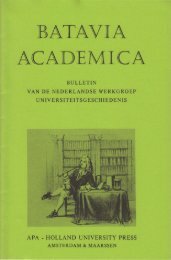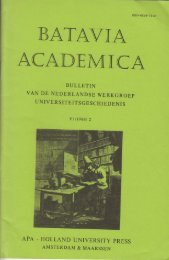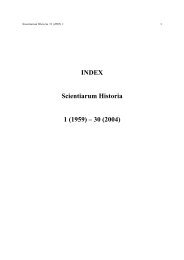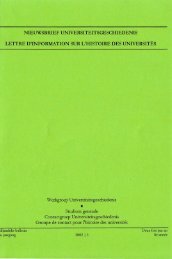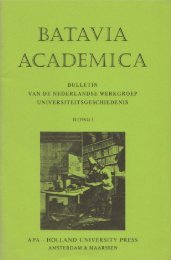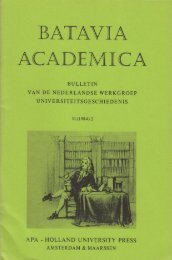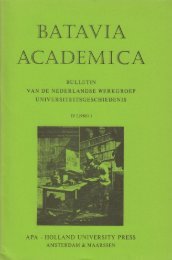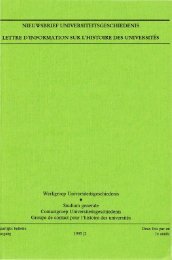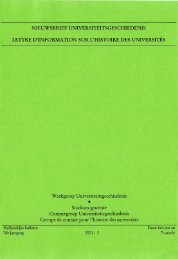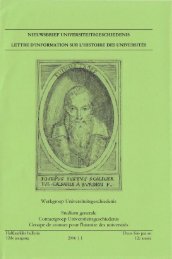the ocular harpsichord of louis-bertrand castel - Gewina
the ocular harpsichord of louis-bertrand castel - Gewina
the ocular harpsichord of louis-bertrand castel - Gewina
Create successful ePaper yourself
Turn your PDF publications into a flip-book with our unique Google optimized e-Paper software.
Castel's <strong>ocular</strong> <strong>harpsichord</strong> 67<br />
in early Romantic England, and <strong>the</strong>re, one person only seems to have passed on<br />
<strong>the</strong> Castellian notion <strong>of</strong> colour music. In <strong>the</strong> prose interludes <strong>of</strong> his famous<br />
poem The loves <strong>of</strong> <strong>the</strong> plants, first published in 1789, Erasmus Darwin mentioned<br />
Newton's "happy discovery" <strong>of</strong> <strong>the</strong> analogy <strong>of</strong> spectral colours and <strong>the</strong><br />
minor scale proposal <strong>of</strong> deducing a luminous music from this analogy by Fa<strong>the</strong>r<br />
Cassel [sic]. He accepted <strong>the</strong> conclusion that <strong>the</strong>re was "a sisterhood <strong>of</strong> music<br />
and painting", and added that "hence <strong>the</strong>y claim a right to borrow metaphors<br />
from each o<strong>the</strong>r; musicians to speak <strong>of</strong> <strong>the</strong> brilliancy <strong>of</strong> sounds, emd <strong>the</strong> light<br />
and shade <strong>of</strong> a concerto; and painters <strong>of</strong> <strong>the</strong> harmony <strong>of</strong> colours, and <strong>the</strong> tone<br />
<strong>of</strong> a picture.""' If Castel's colour music did play any role in English Romantic<br />
poetry, Darwin is a very likely source, since his poems had a great influence on<br />
<strong>the</strong> next generation <strong>of</strong> poets, particularly Shelley.''"'<br />
Interestingly enough, Darwin was <strong>the</strong> first to be able to defend colour<br />
harmony by a physiological argument, answering one <strong>of</strong> <strong>the</strong> most frequently<br />
raised objections against Castel, i.e. that <strong>the</strong> difference between <strong>the</strong> organs <strong>of</strong><br />
hearing and sight was too great to support any analogy. Somewhere in <strong>the</strong> early<br />
1770's Darwin had discovered <strong>the</strong> phenomenon <strong>of</strong> <strong>the</strong> afterimage, which has a<br />
colour complementary to <strong>the</strong> colour <strong>of</strong> <strong>the</strong> object itself. In The love <strong>of</strong> <strong>the</strong> plants<br />
he proposed this as <strong>the</strong> physiological basis for colour harmony, in that on <strong>the</strong><br />
retina <strong>the</strong> colour <strong>of</strong> <strong>the</strong> afterimage caused by <strong>the</strong> last object would interfere with<br />
<strong>the</strong> real colour <strong>of</strong> <strong>the</strong> next object. It is sad that this discovery came too late to<br />
be able to join <strong>the</strong> debate on colour music.'"'<br />
Conclusion<br />
It might seem strange that at <strong>the</strong> same moment when synaes<strong>the</strong>tic imagery<br />
became a frequently used stylistic device, <strong>the</strong> <strong>ocular</strong> <strong>harpsichord</strong> and <strong>the</strong> colour<br />
music it was supposed to play disappeared out <strong>of</strong> sight. However, with its<br />
entrance in poetry, <strong>the</strong> harmony <strong>of</strong> <strong>the</strong> senses became a thing <strong>of</strong> <strong>the</strong> imagination,<br />
to be treated in many kinds <strong>of</strong> ways, only not as a truthful description <strong>of</strong><br />
Darwin, Love, 3rd Interlude, pp. 140-141. Darwin repeated all this almost verbatim in <strong>the</strong><br />
"Additional notes" to his posthumous poem 77i* temple <strong>of</strong> nature (1803), under <strong>the</strong> heading "MelcxJy<br />
<strong>of</strong> colours". Darwin seems to have derived his knowledge <strong>of</strong> <strong>the</strong> <strong>ocular</strong> <strong>harpsichord</strong> from Guyot's<br />
Recreations'.<br />
140<br />
See Desmond King-Hele, Erasmus Darwin and <strong>the</strong> Romantic poets (London, 1986). For an<br />
extensive documentation on <strong>the</strong> emergence <strong>of</strong> synaes<strong>the</strong>tic imagery in poetry, see <strong>the</strong> writings <strong>of</strong><br />
Von Erhardt-Siebold and Weliek.<br />
141<br />
Darwm, Love, p. 141. The existence <strong>of</strong> <strong>the</strong> afterimage vras announced by Erasmus' son<br />
Robert, <strong>the</strong> fa<strong>the</strong>r <strong>of</strong> Charles Darwin, in <strong>the</strong> Philosophical Transactions <strong>of</strong> <strong>the</strong> Royal Society 76,<br />
1786, but <strong>the</strong> original discovery was almost certainly his fa<strong>the</strong>r's. See Desmond King-Hele, Doctor <strong>of</strong><br />
revolution: <strong>the</strong> life and genius <strong>of</strong> Erasmus Darwin (London, 1977), p. 177.



